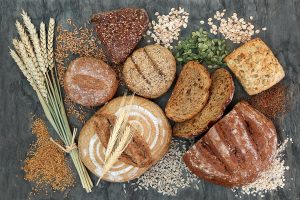 While carbs often get a bad reputation, they are an important component of any diet.
While carbs often get a bad reputation, they are an important component of any diet.
Understanding what the healthiest grains are can be challenging- and we certainly don’t have the right answers – but we have included a couple suggestions for choosing climate-friendly choices.
- Choose whole wheat options to reduce emissions. Making white bread involves milling, which removes almost all of the nutritional value of the grain. To compensate for these lost nutrients, other processed additives are included. Due to these processes, white bread requires more energy than whole wheat options (3).
- Make your own breads, wraps, and baking using local flours. This option will reduce the need for transporting bread products long distances, reduce the need for preservatives, and reduce the plastic packaging.
- Buy local. Manitoba is part of the bread belt of Canada, and is one of the top grain producing areas of the world. However, we still ship in a lot of non-local grains, which contribute to our food print.
Case Study: Quinoa & Chia Seeds vs. Local Alternatives
The North American demand for quinoa has led to South American farmers focusing only on producing a few of the 3,000 varieties available (read more here). Moving away from planting a diverse crop of quinoa reduces the ability of crop species to adapt to climate change.
The quinoa boom has forced farmers to use all of the land available, rather than leaving some as fallow. As a result, the soil is suffering from erosion and nutrient loss. By transitioning to more quinoa, producers are also no longer are able to keep livestock as a source of natural fertilizer. The use of chemical fertilizers has further impacted the soil health.
As a unprocessed grain, quinoa has high nutritional value. However, when it is processed for many of the items in grocery stores, most of the healthy components are lost. Therefore, experts suggest sticking to a local plant, such as a potato, instead of purchasing imported quinoa from the distant countries of Peru, Bolivia, and Ecuador.
It is a similar story for chia seeds. Due to their recent popularity, chia seeds are imported from Argentina, Peru, Bolivia, and Ecuador in alarming quantities.
However, dieticians suggest that the same benefits can be gained from local crops, such as ground flaxseed and buckwheat. The health benefits are essentially on par, plus choosing local alternatives saves you money and saves the planet emissions.
Also, there is now at least one Manitoba producer of quinoa – Prairie Quinoa markets locally grown amber quinoa.




